Family: Delphinidae
Genus: Cephalorhynchus
Species: C. commersonii (Lacépède, 1804)
Like the other three members of the genus Cephalorhynchus (Chilean or black dolphin, Heaviside’s dolphin, and Hector’s dolphin), Commerson’s dolphin inhabits waters of the Southern Hemisphere exclusively, and little is known about it. Also like the other members of its genus, Commerson’s dolphin has a short, rounded dorsal fin, rounded paddle-shaped flippers, and flukes wider than might be expected for an animal of its size. The appearance of its face closely resembles that of the harbor porpoise.
Physical Description: This animal is small and stocky, resembling a fat harbor porpoise. The small, underdeveloped rostrum does not protrude.
Color: The head, neck, flippers and flukes are black and distinctly separated from the snow-white dorsal region which extends from the forehead back past the dorsal fin and on either flank to the underside just past the large black patch on the anus. The black region begins again along the dorsal ridge running down the sides of the peduncle including the dorsal fin and the entire fluke region.
Fins and Flukes: The prominent, rounded dorsal fin meets a slight dorsal ridge as it falls to the rear. The ridge runs halfway down the peduncle with little or no discernable falcation in the dorsal fin itself. The small flippers are rounded on the leading edges and tips. The small flukes are crescent shaped, rounded at the tips, with a well-defined median notch.
Length and Weight: A mature female caught off of south Patagonia was 4.5 ft (1.36 m) in length and weighed 51 lb (23 kg).
Teeth: 29 to 30 small conical teeth are found in each side of the upper and lower jaws.
Feeding: Krill, cuttlefish, squid, shrimp, and small fish.
Breathing and Diving: Commerson’s dolphins are often seen swimming in the bow-wake of passing ships. Their normal dive time is 15 to 20 seconds, with swimming speeds of 7 to 8.5 mph (10 to 13.5 kph).
Mating and Breeding: Study of fetuses suggests calving in early austral summer. The young are born all brown and develop adult markings with age.
Herding: Individually, or in small groups from 6 to 30. A herd of about 100 was once sighted.
Distribution: Southern tip of South America, Strait of Magellan, Tierra del Fuego, Falkland Islands, South Georgia, and Kerguelen Island.
Migration: No information is available.
Natural History Notes: These animals are extremely active. Observations report repeated high leaps from the water. Their swimming pattern may be erratic, making it difficult to tell where they will surface next.
COMMERSON’S DOLPHIN DISTRIBUTION








